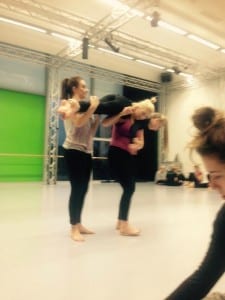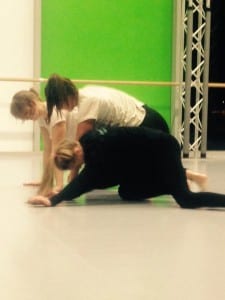At the beginning of today’s session we began watching the round robin that we participated in from the previous weeks. It was interesting to watch this to see how I moved during contact improvisation, as when I am moving in class I feel quite clumsy. However, I perceived myself to be quite fluid in my movements than I initially thought when I watched myself on video as I could see that I maintained a equal role of being the over and under dancer. It was surprising to see how comfortable I was working with people I have rarely worked with before, as this would be something I would be reluctant to do at the beginning on the semester. Additionally, it was encouraging to see that I am now able to smoothly transition between the roles of the under and over dancer and give my weight safely to others rather than just reverting back to the under dancer, which used to be a continuing habit of mine. I feel I can improve on creating different surfaces with my body to receive people’s weight on. This is because when someone gives me their weight, I create a stable base for them but I appear to be just a static object. Therefore, if I was to continually move with my partner by creating different surfaces for them to give me their weight, the contact improvisation would appear to be more interesting and fluid.
The first exercise was aimed at exploring the idea of ‘hooking’. As a collective group we appear to use hooking in our ‘jam’ sessions as a way to move our partner around the space. However, this has an impact on how our partner can move and they are constrained to where there partner wants them to go and therefore restricts them from moving freely. We explored in our partners the idea of hooking where one partner would be the under and use their arms and hands to control the over dance and vice versa. After proving our restricted this felt, we then develop them by dismissing the idea of hooking and allow the over dance to move freely. It became clear that by not using hooking it was much easier to move with your partner because you could easily alternate the roles of the over and under dancer and create more opportunities. This is something that I would like to pay attention to when I am performing contact improvisation as I have realised that ‘hooking’ isn’t necessary as I can just listen to my partners body and where they want to move and immediately respond to it.
One exercise that we attended to in this class consisted of a floor exercise, experimenting with our pelvis through space. A common collective fault in contact improvisation and one I noticed that I don’t do personally is effectively using the pelvis to move on and off different bodies. Therefore, this task was used to develop the idea of moving with our pelvis first to move on and off bodies fluidly. The next exercise consisted of exploring this idea in partners to ingrain this idea of safely moving with our pelvis into our minds. Partner A would create a surface for partner B to execute their pelvis on and become the over dancer. Initially, I found it difficult to throw my weight onto my partner, pelvis first, as I was worried that as a duo we would collapse and I would hurt my partner. However, after I attempted this a few times I was able to relax, let my body lead the movement and I became more comfortable with the idea of letting my pelvis initiate the improvisation. This exercise enabled me to understand that if I was lead from the pelvis it would create more opportunities for me to move with my partner. As well as this, it would allow my partner to feel when I have arrived at their surface so as a duo we can explore how this can initiate movement and proceed further into creating an improvisation duet. This is more beneficial than just launching myself unexpectedly at my partner as I am maintaining a safe practice and it gives my partner time to react.
This exercise was then developed into leading with the legs. Therefore partner A would create a stable base whilst partner B would initiate movement from the legs to execute themselves on and off their partner’s body. Personally, I felt less comfortable leading with my legs, especially when my partner create higher surfaces for me to move onto. On the other hand, it was exciting to see how I could create better contact positions by initiating movement with my legs and letting the rest of my body follow. Also, it enabled less weight and pressure to be applied to my pressure as before I was putting the majority of my weight onto my partner by leading with me pelvis. The final contact exercise that we explored was the notion of pouring our pelvis onto our partner. This sensation of pouring your pelvis onto your partner allows you to maintain a sense that you have arrived safely onto your partners back and so you partner can listen to your body and know that you have arrived safely. It becomes more effective than just launching yourself onto your partner and rushing to create some form of contact with them because once you have placed yourself safely onto your partner, you have created more opportunities to move.
Towards the end of the session, we formulated an contact score in our groups to be performed at the open studios. As we devised our contact score, the reading by Jamie Stover Some Considerations When Structuring an Improvisation was taken into consideration. A contact score can be structured in a variety of ways. A score can be based on a formal, relative structure that allows the audience to see the action better and is not altered throughout the performance or a score that has no performance purpose and no reliance on rules but individuals in the dance can influence changes and alter parts. My group decided to create a score that was based around a loose structure and some required rules. When creating our score, it was essential that we filled and emptied the space, fulfilling the idea of spatial rhythm that was discussed in class. Our contact score was based on the following principles:
- A Maximum of eight dancers had to present in the space at all times, there can be less but no more eight
- Maximum of two dancers sitting out of the space at all times
- When one dancer enters the space, another dancer must follow to form a duet. Upon entering the space, they are required to maintain contact and travel to the opposite side of the room
- There are opportunities for solos and trios in the space but when a third person joins the duet to form a trio, they must change the direction and momentum of the dance
Our score will be developed further and refined over the next couple of weeks in preparation for the open studios but one aspect that we need to take into great consideration is the levels we use. It was apparent to the people watching that we all have a tendency to move along the floor, dismissing the idea of using higher levels. Therefore, as a group we need to ensure we are using a range of levels as well as a range of dynamics to make the improvisation more creative and interesting.
Bibliography
Stover, J. (1989). Some Considerations When Structuring an Improvisation (to be seen by an audience). Contact Quarterly/ Contact Improvisation Sourcebook II, (14)185.


